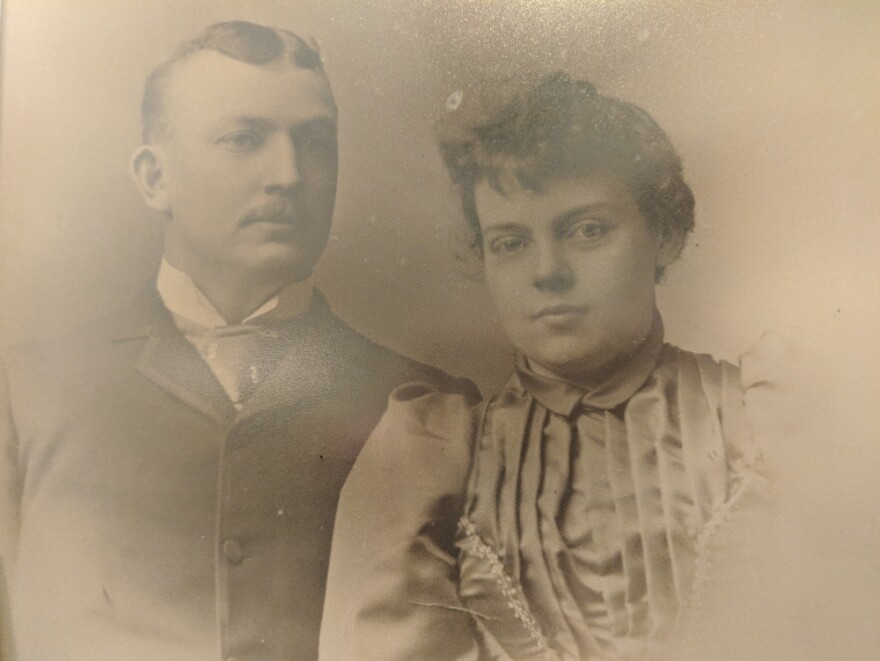Each season, Major League Baseball honors the best pitcher in both leagues with the award named for an Ohioan from Tuscarawas County — Cy Young.
Cleveland author Scott Longert shares the history of this legendary pitcher, who played some of his best baseball in Cleveland, in his new biography for kids, "Cy Young: An American Baseball Hero."
Born just a couple of years after the end of the Civil War in 1867, Denton True Young grew up working on his family's farm in Gilmore, Ohio.
The Young family home in Gilmore, Ohio, c.1880 [Newcomerstown Historical Society]
Denton, or Dent as he was called, spent his free time playing catch and throwing whatever he could get his hands on — baseballs, apples, even walnuts.
In 1890, Young got a pitching tryout for Canton's minor league team. Baseball historian Scott Longert says he also acquired his nickname that day.
"He let a fastball go, and it came in so quickly the catcher jumped out of the way and let the ball go. It hit the wooden grand stand on the fly and splintered a couple pieces of wood. He did that several more times and one of the people that was watching in the stands yelled out loud, 'Look at that guy! He throws just like a cyclone!'" Longert said.
From then on the Ohio farmboy with the overpowering fastball would be known as Cyclone, which his teammates soon shortened to Cy.
Young was promoted from Canton to the major league quickly when he was acquired that same season by the Cleveland Spiders.
Team photo of the Cleveland Spiders, 1895 (Cy Young back row center) [National Baseball Hall of Fame and Museum]
"Cleveland was an up and coming city and along with it they had an up and coming ball club," Longert said.
Near the end of his rookie season, Young pitched and won both games of a double header for Cleveland.
The Cleveland Spiders were owned by Frank Robison, who made his fortune on the city's streetcar system.
In 1891, Robison opened a new baseball stadium at the corner of 66th Street and Lexington Avenue — League Park.
League Park, Cleveland, c.1910 [Scott Longert collection]
Young was the obvious choice to pitch League Park's first opening day against the Spiders' intrastate rival.
"This was a huge event and you wanted to start off with a bang really, and Cy was the starting pitcher against the Cincinnati Reds. Cy pitched a great game, and the Spiders, as we were being called now, had a good ball game and we won the game. That was a sign of good things to come," Longert said.
In the 1890s, there was only the National League and its champion was crowned after a best-of-seven playoff — The Temple Cup.
Young led the Spiders to the Temple Cup in 1895, as the second place team in the National League, facing off against the first place Baltimore Orioles.
During the seven-game series the Spiders leaned on their ace.
"He was the guy basically. He won three ball games. He pitched every other day. The Baltimore team couldn't touch him. He was just outstanding," he said.
Cy Young, Cleveland Naps, baseball card portrait, 1911 [Library of Congress]
The Spiders won Cleveland's first baseball championship four games to one over the Orioles endearing Young to the city and its fans.
The following season in 1896, Young took the Spiders to a second Temple Cup once again facing the Orioles.
In the first game of the series, however, on the very first pitch, Young was hit on the wrist by a comebacker to the mound.
The Spiders went on to lose the game and eventually the series because Young couldn't pitch after the injury.
That was the last time Young and the Spiders would play for the championship, but in 1897, in a game against Cincinnati, Young pitched the first of his three career no-hitters.
In 1899, Spiders owner Frank Robison bought the St. Louis ball club and took Young and the team's other best players with him.
It was a sad day for Young to leave the city he'd grown to love.
Cy and Bobby Young, 1892 [Newcomerstown Historical Society]
"Well this became his second home really. Since it was very close to where he lived, it was a train ride, maybe an hour and a half at the most, he could have Bobby, his wife, come and see him and stay with him during the season. His family, his friends could come up to watch him. So he was very comfortable here," he said.
The second half of Young's career took place mostly in Boston during what's known as the modern era of baseball, which began in 1900.
He won the first World Series with the American League Boston Braves in 1903. The next year he was the first pitcher of the modern era to throw a perfect game.
Despite his late career success in Boston, Cleveland was always Young's second home.
"He came back for his first visit to Cleveland as a pitcher. He was overjoyed that hundreds of people he knew came to the ballpark to see him, and many more went to the Cleveland hotel just to come to talk with him and shake hands," Longert said.
Cy Young with the Cleveland Naps, c. 1910 [National Baseball Hall of Fame and Museum]
As his career drew to a close, Young returned to Cleveland in 1909 to play for the city's new American League team, the Naps, later to become the Indians, where in 1910 Young won his 500th game, a record that still stands today.
Scott Longert's " Cy Young: An American Baseball Hero" is published by Ohio University Press.
A post shared by ideastream (@ideastreamneo) on


![Cy Young in his Cleveland Spiders uniform c. 1893 [National Baseball Hall of Fame and Museum] / Book cover [Ohio University Press]](https://npr.brightspotcdn.com/dims4/default/e7279e9/2147483647/strip/true/crop/3000x1826+0+0/resize/880x536!/quality/90/?url=http%3A%2F%2Fnpr-brightspot.s3.amazonaws.com%2Flegacy%2Fuploads%2F2020%2F8%2F20%2FCy%20Young%20Web2.jpg)







